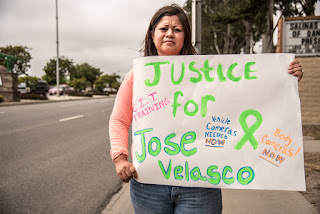Sitting Freely in Downtown Monterey

At their latest monthly sit-in, community members protesting the sit-lie ban in Monterey sat freely on the sidewalk on Alvarado Street for the first time since beginning their protests. At each of the four previous sit-ins, demonstrators were pressured to discontinue the protest, either by the police or by downtown business owners. They have been gathering on Alvarado Street monthly since February to oppose the new Monterey ordinance, which outlaws sitting or lying on commercial sidewalks in the city between the hours of 7am and 9pm. They have scheduled their demonstrations monthly to avoid being cited under the law. To receive a citation, an individual must first be warned by police. "No person may be cited for a violation of this section until a peace officer first warns said person that his or her conduct is unlawful and said person is given a change [chance] to stop said conduct," the ordinance (Sec. 32-6.2) reads. "One warning by a peace officer to a person wh...




